13: Iodine Clock Reaction
- Page ID
- 204137
\( \newcommand{\vecs}[1]{\overset { \scriptstyle \rightharpoonup} {\mathbf{#1}} } \)
\( \newcommand{\vecd}[1]{\overset{-\!-\!\rightharpoonup}{\vphantom{a}\smash {#1}}} \)
\( \newcommand{\id}{\mathrm{id}}\) \( \newcommand{\Span}{\mathrm{span}}\)
( \newcommand{\kernel}{\mathrm{null}\,}\) \( \newcommand{\range}{\mathrm{range}\,}\)
\( \newcommand{\RealPart}{\mathrm{Re}}\) \( \newcommand{\ImaginaryPart}{\mathrm{Im}}\)
\( \newcommand{\Argument}{\mathrm{Arg}}\) \( \newcommand{\norm}[1]{\| #1 \|}\)
\( \newcommand{\inner}[2]{\langle #1, #2 \rangle}\)
\( \newcommand{\Span}{\mathrm{span}}\)
\( \newcommand{\id}{\mathrm{id}}\)
\( \newcommand{\Span}{\mathrm{span}}\)
\( \newcommand{\kernel}{\mathrm{null}\,}\)
\( \newcommand{\range}{\mathrm{range}\,}\)
\( \newcommand{\RealPart}{\mathrm{Re}}\)
\( \newcommand{\ImaginaryPart}{\mathrm{Im}}\)
\( \newcommand{\Argument}{\mathrm{Arg}}\)
\( \newcommand{\norm}[1]{\| #1 \|}\)
\( \newcommand{\inner}[2]{\langle #1, #2 \rangle}\)
\( \newcommand{\Span}{\mathrm{span}}\) \( \newcommand{\AA}{\unicode[.8,0]{x212B}}\)
\( \newcommand{\vectorA}[1]{\vec{#1}} % arrow\)
\( \newcommand{\vectorAt}[1]{\vec{\text{#1}}} % arrow\)
\( \newcommand{\vectorB}[1]{\overset { \scriptstyle \rightharpoonup} {\mathbf{#1}} } \)
\( \newcommand{\vectorC}[1]{\textbf{#1}} \)
\( \newcommand{\vectorD}[1]{\overrightarrow{#1}} \)
\( \newcommand{\vectorDt}[1]{\overrightarrow{\text{#1}}} \)
\( \newcommand{\vectE}[1]{\overset{-\!-\!\rightharpoonup}{\vphantom{a}\smash{\mathbf {#1}}}} \)
\( \newcommand{\vecs}[1]{\overset { \scriptstyle \rightharpoonup} {\mathbf{#1}} } \)
\( \newcommand{\vecd}[1]{\overset{-\!-\!\rightharpoonup}{\vphantom{a}\smash {#1}}} \)
\(\newcommand{\avec}{\mathbf a}\) \(\newcommand{\bvec}{\mathbf b}\) \(\newcommand{\cvec}{\mathbf c}\) \(\newcommand{\dvec}{\mathbf d}\) \(\newcommand{\dtil}{\widetilde{\mathbf d}}\) \(\newcommand{\evec}{\mathbf e}\) \(\newcommand{\fvec}{\mathbf f}\) \(\newcommand{\nvec}{\mathbf n}\) \(\newcommand{\pvec}{\mathbf p}\) \(\newcommand{\qvec}{\mathbf q}\) \(\newcommand{\svec}{\mathbf s}\) \(\newcommand{\tvec}{\mathbf t}\) \(\newcommand{\uvec}{\mathbf u}\) \(\newcommand{\vvec}{\mathbf v}\) \(\newcommand{\wvec}{\mathbf w}\) \(\newcommand{\xvec}{\mathbf x}\) \(\newcommand{\yvec}{\mathbf y}\) \(\newcommand{\zvec}{\mathbf z}\) \(\newcommand{\rvec}{\mathbf r}\) \(\newcommand{\mvec}{\mathbf m}\) \(\newcommand{\zerovec}{\mathbf 0}\) \(\newcommand{\onevec}{\mathbf 1}\) \(\newcommand{\real}{\mathbb R}\) \(\newcommand{\twovec}[2]{\left[\begin{array}{r}#1 \\ #2 \end{array}\right]}\) \(\newcommand{\ctwovec}[2]{\left[\begin{array}{c}#1 \\ #2 \end{array}\right]}\) \(\newcommand{\threevec}[3]{\left[\begin{array}{r}#1 \\ #2 \\ #3 \end{array}\right]}\) \(\newcommand{\cthreevec}[3]{\left[\begin{array}{c}#1 \\ #2 \\ #3 \end{array}\right]}\) \(\newcommand{\fourvec}[4]{\left[\begin{array}{r}#1 \\ #2 \\ #3 \\ #4 \end{array}\right]}\) \(\newcommand{\cfourvec}[4]{\left[\begin{array}{c}#1 \\ #2 \\ #3 \\ #4 \end{array}\right]}\) \(\newcommand{\fivevec}[5]{\left[\begin{array}{r}#1 \\ #2 \\ #3 \\ #4 \\ #5 \\ \end{array}\right]}\) \(\newcommand{\cfivevec}[5]{\left[\begin{array}{c}#1 \\ #2 \\ #3 \\ #4 \\ #5 \\ \end{array}\right]}\) \(\newcommand{\mattwo}[4]{\left[\begin{array}{rr}#1 \amp #2 \\ #3 \amp #4 \\ \end{array}\right]}\) \(\newcommand{\laspan}[1]{\text{Span}\{#1\}}\) \(\newcommand{\bcal}{\cal B}\) \(\newcommand{\ccal}{\cal C}\) \(\newcommand{\scal}{\cal S}\) \(\newcommand{\wcal}{\cal W}\) \(\newcommand{\ecal}{\cal E}\) \(\newcommand{\coords}[2]{\left\{#1\right\}_{#2}}\) \(\newcommand{\gray}[1]{\color{gray}{#1}}\) \(\newcommand{\lgray}[1]{\color{lightgray}{#1}}\) \(\newcommand{\rank}{\operatorname{rank}}\) \(\newcommand{\row}{\text{Row}}\) \(\newcommand{\col}{\text{Col}}\) \(\renewcommand{\row}{\text{Row}}\) \(\newcommand{\nul}{\text{Nul}}\) \(\newcommand{\var}{\text{Var}}\) \(\newcommand{\corr}{\text{corr}}\) \(\newcommand{\len}[1]{\left|#1\right|}\) \(\newcommand{\bbar}{\overline{\bvec}}\) \(\newcommand{\bhat}{\widehat{\bvec}}\) \(\newcommand{\bperp}{\bvec^\perp}\) \(\newcommand{\xhat}{\widehat{\xvec}}\) \(\newcommand{\vhat}{\widehat{\vvec}}\) \(\newcommand{\uhat}{\widehat{\uvec}}\) \(\newcommand{\what}{\widehat{\wvec}}\) \(\newcommand{\Sighat}{\widehat{\Sigma}}\) \(\newcommand{\lt}{<}\) \(\newcommand{\gt}{>}\) \(\newcommand{\amp}{&}\) \(\definecolor{fillinmathshade}{gray}{0.9}\)Objectives
- To determine the effects of temperature and a catalyst on the rate of a chemical reaction.
Introduction
We have studied the effects of concentration on the rate of the reaction in last week’s experiment. This week we will look at other factors that may affect the rate; temperature and catalysts.
The reaction we will be studying is:
\[ \ce{H_{2}O_{2}} + \ce {2I^{-}} + \ce{2H^{+}} \ce{->} \ce{I_{2}} + \ce{2H_{2}O} \label{1}\]
There is another reaction involved that changes color to let us know when Reaction 1 is complete, but it does not play a role in the kinetics.
Previous determinations have found that the rate law for this reaction is:
\[Rate = k \ce{[H_{2}O_{2}]}\ce{[I^{-}]} \label{2}\]
That is, the reaction is first order with respect to both hydrogen peroxide and iodide.
In this experiment, we will examine the effects of both temperature (cold and hot) and the effect of a catalyst on the rate of the reaction.
Note that since the clock reaction is relatively fast, the \(\ce{I2(aq)}\) will be consumed by the clock reaction as quickly as it can be produced by the reaction of interest thus holding the \(\ce{I2}\) concentration at a very low value close to zero. Only after the \(\ce{S2O3^{2-}} \) has been entirely consumed will the concentration of \(\ce{I2}\) start to increase. After the \(\ce{S2O3^{2-}} \) has been consumed the concentration of \(\ce{I2}\) will increase rapidly allowing the \(\ce{I2}\) to react with a starch indicator resulting in the solution turning to a deep blue color.
Catalysts increase the rate of a chemical reaction by providing an alternate pathway or mechanism through which a reaction can proceed. Since the alternate mechanism has a lower activation energy than that of the uncatalyzed reaction the effect of the catalyst is to increase the rate of the reaction. To demonstrate the effect of a catalyst on the reaction rate you will repeat one of the trials from Part A in the presence of an ammonium molybdate, \( \ce{(NH4)2MoO4}\), a catalyst.
Pre Lab Video
Procedure
Safety and Waste Disposal
- Solutions from the catalyst portion must be collected and placed in the hazardous waste container.
Part I: Temperature Effects
Room Temperature
Step 1
 In a 100 mL beaker, add (using your graduated cylinder) 8.0 mL of water, 3.0 mL of acetate buffer, 3.0 mL of potassium iodide solution, 1.0 mL of starch solution and 1.0 mL of sodium thiosulfate solution. Mix well. Measure the temperature of the solution.
In a 100 mL beaker, add (using your graduated cylinder) 8.0 mL of water, 3.0 mL of acetate buffer, 3.0 mL of potassium iodide solution, 1.0 mL of starch solution and 1.0 mL of sodium thiosulfate solution. Mix well. Measure the temperature of the solution.
Step 2
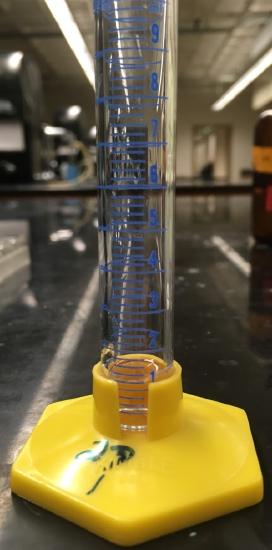 Obtain 1.0 mL of hydrogen peroxide in a different graduated cylinder than you used to measure the reagents in step 1.
Obtain 1.0 mL of hydrogen peroxide in a different graduated cylinder than you used to measure the reagents in step 1.
Step 3
 Simultaneously add the hydrogen peroxide to the beaker and start the stop watch.
Simultaneously add the hydrogen peroxide to the beaker and start the stop watch.
Step 4
Observe the solution. When you see a change, stop timing and record the time.
Step 5
Repeat steps 1-4 until you have two times that are within 10 seconds of each other.
Cold Temperature
Step 1
 Obtain and mix the reagents in the same volumes as in step 1 for the room temperature solution.
Obtain and mix the reagents in the same volumes as in step 1 for the room temperature solution.
Step 2
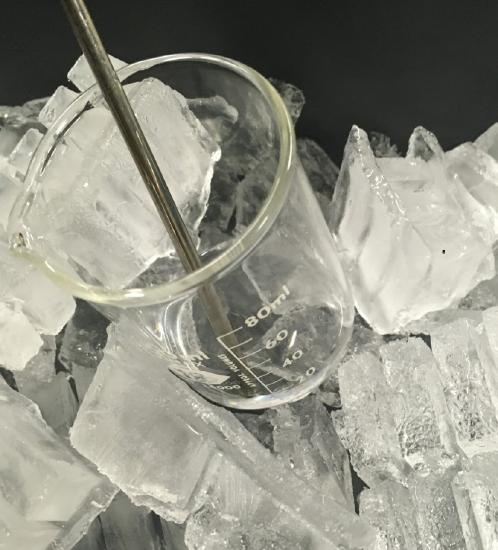 Place the beaker in a water bath with ice. Measure the temperature on the solution. Leave the solution in the bath until the temperature is at least \(10^{o}\)C colder than the room temperature solution.
Place the beaker in a water bath with ice. Measure the temperature on the solution. Leave the solution in the bath until the temperature is at least \(10^{o}\)C colder than the room temperature solution.
Step 3
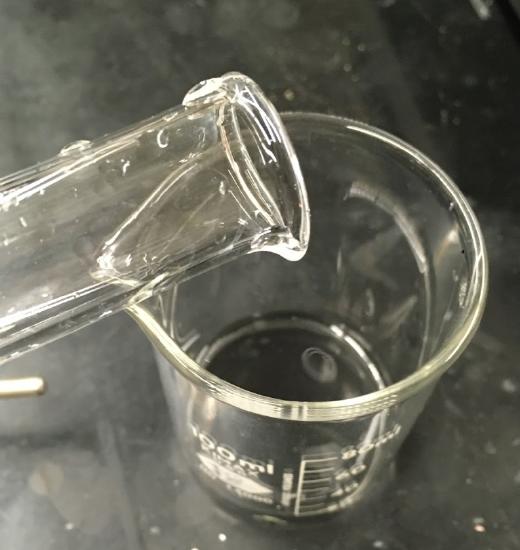 Add the hydrogen peroxide as in step 2 of the room temperature solution and record the time at which the solution changes.
Add the hydrogen peroxide as in step 2 of the room temperature solution and record the time at which the solution changes.
Step 4
Repeat until your times are no more than 30 seconds apart.
Hot Temperature
Step 1
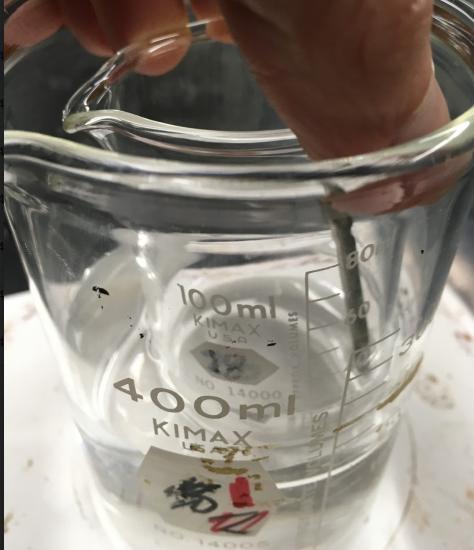 Repeat the Cold Temperature procedure using a hot water bath rather than an ice bath. The temperature should be at least \(10^{o}\)C warmer than the room temperature solution.
Repeat the Cold Temperature procedure using a hot water bath rather than an ice bath. The temperature should be at least \(10^{o}\)C warmer than the room temperature solution.
Step 2
Times should be no more than 8 seconds apart.
Part II: Catalyst
Warning
Do this part last as the catalyst may contaminate your other runs.
Step 1
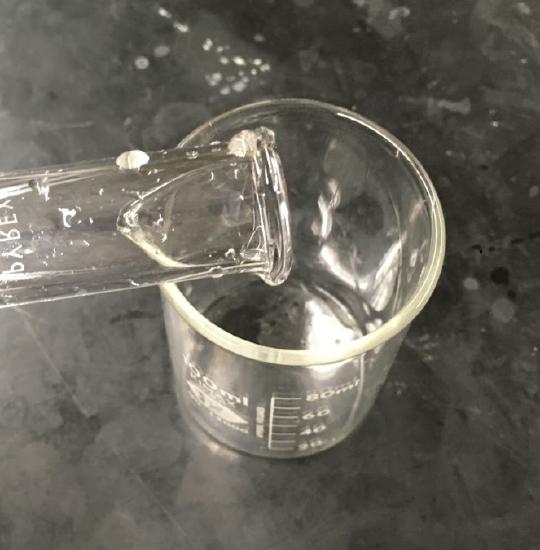 Mix the same reagents as in Step 1 of the room temperature trial.
Mix the same reagents as in Step 1 of the room temperature trial.
Step 2
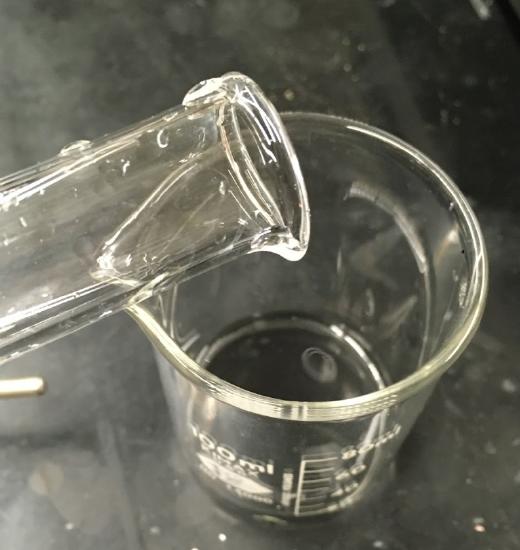 Add 1.0 mL ammonium molybdate solution to the beaker. Stir well.
Add 1.0 mL ammonium molybdate solution to the beaker. Stir well.
Step 3
 Obtain 1.0 mL hydrogen peroxide. Add the peroxide and time as before.
Obtain 1.0 mL hydrogen peroxide. Add the peroxide and time as before.
Step 4
Dispose in a waste container and wash your beaker out well. Repeat until you have times that are no more than 5 seconds apart.
Calculations
Step 1
Since we are not changing the concentrations, we can approximate the rate to equal 1/time. Calculate the two closest rates for each sets of reactions (room temperature, hot, cold and catalyst) and average the results.
Step 2
Calculate the ratio of the room temperature reaction to the rate of the reaction in the cold water bath.
\[\frac{Rate (RT)}{Rate (Cold)}\]
Step 3
Calculate the ratio of the reaction in the hot water bath to the rate of the room temperature reaction.
\[\frac{Rate (Hot)}{Rate (RT)}\]
Step 4
Calculate the ratio of the catalyst reaction to the rate of the room temperature reaction.
\[\frac{Rate (Catalyst)}{Rate (RT)}\]

